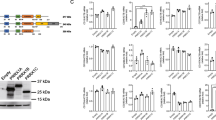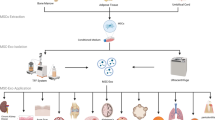Abstract
Mesenchymal stromal cells (MSCs) have been applied in prevention from allograft rejection based on their immunomodulatory effects. However, conflicting results have been presented among recent studies, for which one possibility being acknowledged is that the exact effect is determined by the microenvironment when MSCs are applied in vivo. Using a hind limb composite tissue allograft model, we investigate the influence of IFN-γ-preconditioning on the immunomodulatory effects of MSCs and the subsequent allograft survival. Firstly, different doses of IFN-γ were respectively used to incubate with bone marrow–derived MSCs (BMSCs). We found that IFN-γ altered the expression of PD-L1, a major suppressor gene in the immune system during allograft rejection, in a strictly dose-dependent manner in BMSCs. Ten nanograms per milliliter IFN-γ-incubated BMSCs significantly stimulated PD-L1 expression and suppressed T cell proliferation and differentiation, while 50 ng/mL IFN-γ-incubated BMSCs sharply reduced PD-L1 expression. Moreover, we observed that, in contrast to the naive BMSC transplantation group, BMSCs pre-conditioned with 10 ng/mL IFN-γ (BMSCs-IFN-γ) significantly delayed the allograft rejection in vivo. In vitro mixed lymphocyte reaction (MLR) indicated that BMSCs-IFN-γ inhibited T lymphocyte proliferation and activation via PD-L1. Moreover, BMSCs-IFN-γ did not influence the proliferation and activation of T lymphocytes when PD-L1 protein was neutralized by the PD-L1 antibody. These data collectively reveal a role of recipient ongoing immune microenviroment in BMSC-based immunesuppressive therapy.

ᅟ






Similar content being viewed by others
References
Baron F, Storb R (2012) Mesenchymal stromal cells: a new tool against graft-versus-host disease? Biol Blood Marrow Transplant 18:822–840
Blank C, Mackensen A (2007) Contribution of the PD-L1/PD-1 pathway to T-cell exhaustion: an update on implications for chronic infections and tumor evasion. Cancer Immunol Immunother 56:739–745
Broekman W, Amatngalim GD, Mooijeijk YD, Oostendorp J, Roelofs H, Taube C, Stolk J, Hiemstra PS (2016) TNF-α and IL-1β-activated human mesenchymal stromal cells increase airway epithelial wound healing in vitro via activation of the epidermal growth factor receptor. Respir Res 17:3
Calkoen FG, Vervat C, van Halteren AG, Welters MJ, Veltrop-Duits LA, Lankester AC, Egeler RM, Ball LM, van Tol MJ (2014) Mesenchymal stromal cell therapy is associated with increased adenovirus-associated but not cytomegalovirus-associated mortality in children with severe acute graft-versus-host disease. Stem Cells Transl Med 3:899–910
Collins MC, Gunst PR, Muller-Borer BJ (2014) Functional integration of quantum dot labeled mesenchymal stem cells in a cardiac microenvironment. Methods Mol Biol 1199:141
Cortez M, Carmo LS, Rogero MM, Borelli P, Fock RA (2013) A high-fat diet increases IL-1, IL-6, and TNF-α production by increasing NF-κB and attenuating PPAR-γ expression in bone marrow mesenchymal stem cells. Inflammation 36:379–386
Crowder SW, Liang Y, Rath R, Park AM, Maltais S, Pintauro PN, Hofmeister W, Lim CC, Wang X, Sung HJ (2013) Poly(-caprolactone)-carbon nanotube composite scaffolds for enhanced cardiac differentiation of human mesenchymal stem cells. Nanomedicine 8:1763
De AE, Watkins A, Schäfer M, Brümmendorf T, Kenwrick S (2002) Disease-associated mutations in L1 CAM interfere with ligand interactions and cell-surface expression. Hum Mol Genet 11:1
Fidler SJ, Dorrell L, Ball S, Lombardi G, Weber J, Hawrylowicz C, Rees ADM (1996) An early antigen-presenting cell defect in HIV-1-infected patients correlates with CD4 dependency in human T-cell clones. Immunology 89:46–53
Francisco L, Salinas V, Brown K, Vanguri V, Freeman G, Kuchroo V, Sharpe A (2009) PD-L1 regulates the development, maintenance, and function of induced regulatory T cells. J Exp Med 206:3015–3029
Hettich M, Braun F, Bartholomä MD, Schirmbeck R, Niedermann G (2016) High-resolution PET imaging with therapeutic antibody-based PD-1/PD-L1 checkpoint tracers. Theranostics 6:1629–1640
Jacobs JFM, Idema AJ, Bol KF, Nierkens S, Grauer OM, Wesseling P, Grotenhuis JA, Hoogerbrugge PM, Vries IJMD, Adema GJ (2009) Regulatory T cells and the PD-L1/PD-1 pathway mediate immune suppression in malignant human brain tumors. Neuro-Oncology 11:348–356
Krampera M, Cosmi L, Angeli R, Pasini A, Liotta F, Andreini A, Santarlasci V, Mazzinghi B, Pizzolo G, Vinante F (2006) Role for interferon-γ in the immunomodulatory activity of human bone marrow mesenchymal stem cells. Stem Cells 24:386–398
Li S, Chen S, Yang L, Li Y (2013) The role of PD-1 and PD-L1 in T-cell immune suppression in patients with hematological malignancies. J Hematol Oncol 6:74
Liao L, Zhao RC (2015) Mesenchymal stem cells and their immunomodulatory properties. Springer, Dordrecht
Mielcarek M, Storb R, Georges GE, Golubev L, Nikitine A, Hwang B, Nash RA, Torokstorb B (2011) Mesenchymal stromal cells fail to prevent acute graft-versus-host disease and graft rejection after dog-leukocyte-antigen haploidentical bone marrow transplantation. Biol Blood Marrow Transplant 17:214–225
Obermajer N, Popp FC, Soeder Y, Haarer J, Geissler EK, Schlitt HJ, Dahlke MH (2014) Conversion of Th17 into IL-17Aneg regulatory T cells: a novel mechanism in prolonged allograft survival promoted by mesenchymal stem cell-supported minimized immunosuppressive therapy. J Immunol 193:4988
Pourgholaminejad A (2016) The effect of pro-inflammatory cytokines on immunophenotype, differentiation capacity and immunomodulatory functions of human mesenchymal stem cells. Cytokine 85:51–60
Rodig N, Ryan T, Allen JA, Pang H, Grabie N, Chernova T, Greenfield EA, Liang SC, Sharpe AH, Lichtman AH (2003) Endothelial expression of PD-L1 and PD-L2 down-regulates CD8+ T cell activation and cytolysis. Eur J Immunol 33:3117
Singh A, Mohan A, Dey AB, Mitra DK (2013) Inhibiting the programmed death 1 pathway rescues Mycobacterium tuberculosis-specific interferon γ-producing T cells from apoptosis in patients with pulmonary tuberculosis. J Infect Dis 208:603–615
Takeshita S, Nakatani K, Takata Y, Kawase H, Sekine I, Yoshioka S (1998) Interferon-gamma (IFN-gamma) and tumor necrosis factor-alpha (TNF-alpha) enhance lipopolysaccharide binding to neutrophils via CD14. Inflamm Res 47:101–103
Tasso R, Ilengo C, Quarto R, Cancedda R, Caspi RR, Pennesi G (2012) Mesenchymal stem cells induce functionally active T-regulatory lymphocytes in a paracrine fashion and ameliorate experimental autoimmune uveitis. Invest Ophthalmol Vis Sci 53:786–793
Tolar J, Blanc KL, Blazar BR (2013) MSCs for graft-versus-host disease. In: Hematti P, Keating A (eds) Mesenchymal stromal cells. Stem cell biology and regenerative medicine. Humana Press, New York
Treacy O, O’Flynn L, Ryan AE, Morcos M, Lohan P, Schu S, Wilk M, Fahy G, Griffin MD, Nosov M, Ritter T (2014) Mesenchymal stem cell therapy promotes corneal allograft survival in rats by local and systemic immunomodulation. Am J Transplant 14:2023–2036
Wang Y, Zheng Z, Wang Y, Liu J, Li N, Hu X, Han F, Liu Y, Hu D (2012) Role of donor-specific regulatory T cells in long-term acceptance of rat hind limb allograft. PLoS One 7(8):e43825
Yang R, Ouyang Y, Li W, Wang P, Deng H, Song B, Hou J, Chen Z, Xie Z, Liu Z (2016) Autophagy plays a protective role in tumor necrosis factor-α-induced apoptosis of bone marrow-derived mesenchymal stem cells. Stem Cells Dev 25:788–797
Acknowledgements
This study was supported by National Natural Science Foundation Youth Program of China (No.81401593).
Author information
Authors and Affiliations
Corresponding author
Additional information
Publisher’s note Springer Nature remains neutral with regard to jurisdictional claims in published maps and institutional affiliations.
Electronic supplementary material
Fig S1
Cells were analyzed by flow cytometry for expression of CD73 and CD34. PE-CD73 and FITC-CD34 were used to demonstrate that individual cells express CD73 but not express CD34. (PNG 59.8 kb)
Fig S2
Effect of 10 ng/ml IFN-γ on the expression of CD 45, CD105, HLA-ABC and HLA-DR in BMSCs. *P <0.05. (PNG 72.0 KB kb)
Rights and permissions
About this article
Cite this article
Wang, Y., Xi, Y., Han, F. et al. Vascularized composite allograft rejection is delayed by infusion of IFN-γ-conditioned BMSCs through upregulating PD-L1. Cell Tissue Res 376, 211–220 (2019). https://doi.org/10.1007/s00441-018-2967-y
Received:
Accepted:
Published:
Issue Date:
DOI: https://doi.org/10.1007/s00441-018-2967-y




